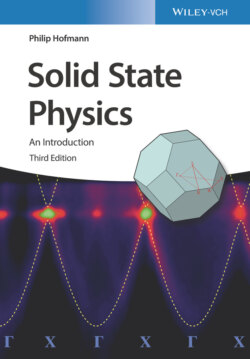Читать книгу Solid State Physics - Philip Hofmann - Страница 40
2.4 Metallic Bonding
ОглавлениеIn metals, the valence electrons of the atoms are removed from the ion cores, but in contrast to ionic solids, there are no electronegative ions to bind them. Therefore, they are free to migrate between the ionic cores. These delocalized valence electrons are involved in the conduction of electricity and are therefore often called conduction electrons. One can expect metals to form from elements for which the energy necessary to remove outer electrons is not too big. Nevertheless, this removal always costs some energy that has to be more than compensated by the resulting bonding. Explaining the energy gain from the bonding in an intuitive manner is difficult, but we will at least try to make it plausible. Obviously, the ultimate reason must be some sort of energy lowering.
One energy contribution that is lowered is the kinetic energy of the conduction electrons. Consider the kinetic energy contribution in a Hamiltonian, . A matrix element measures the kinetic energy of a particle, and is proportional to the second spatial derivative of the wave function, that is, its curvature. For an electron localized at an atom, the curvature of the wave function is much larger than for a nearly free electron in a metal, and this is the origin of the energy gain. A simple implementation of this idea is found in Problem 4, which inspects the lowering of the kinetic energy resulting from delocalization of an electron over the size of a typical crystal unit cell rather than just over the volume of an atom.
The other contribution to electrons' energy is their potential energy. One might think that the average electrostatic potential experienced by any single electron in a solid is almost zero because there are (almost) as many other electrons as there are ions with the same overall amount of charge. This reasoning turns out to be wrong, however. In fact, the electrons experience an overall attractive potential. The reason is again partly due to the Pauli principle, which – in simple terms – does not permit two electrons with the same spin orientation to occupy the same position [see Eq. (2.10)] and therefore requires the electrons to avoid each other. In addition to this, there is also a direct Coulomb interaction between the electrons, which also makes them sidestep each other. We will discuss this in more detail when dealing with magnetism.
We can now also understand why metals prefer close‐packed structures. First of all, metallic bonding does not have any directional preference. Second, close‐packed structures secure the highest possible overlap between the valence orbitals of the atoms, maximizing the delocalization of the electrons and thereby the kinetic energy gain. The resulting structures also maximize the number of nearest neighbors for any given atom, again giving rise to strongly delocalized states.
The picture of metallic bonding described here holds mainly for simple metals with only s and p electrons in the outer shells. For these, metallic bonding is not as strong as covalent or ionic bonding, but the cohesive energy can still amount to 1–2 eV per atom. Stronger bonding is found in transition metals, i.e. metals that have partially filled d shells in addition to the s and p electrons (an overview of the cohesive energies is provided in Figure 4.16). The explanation for this is that a mixed bonding situation arises in these cases. The s and p electrons turn into delocalized metallic conduction electrons, whereas the d electrons create more localized, covalent‐type bonds.
